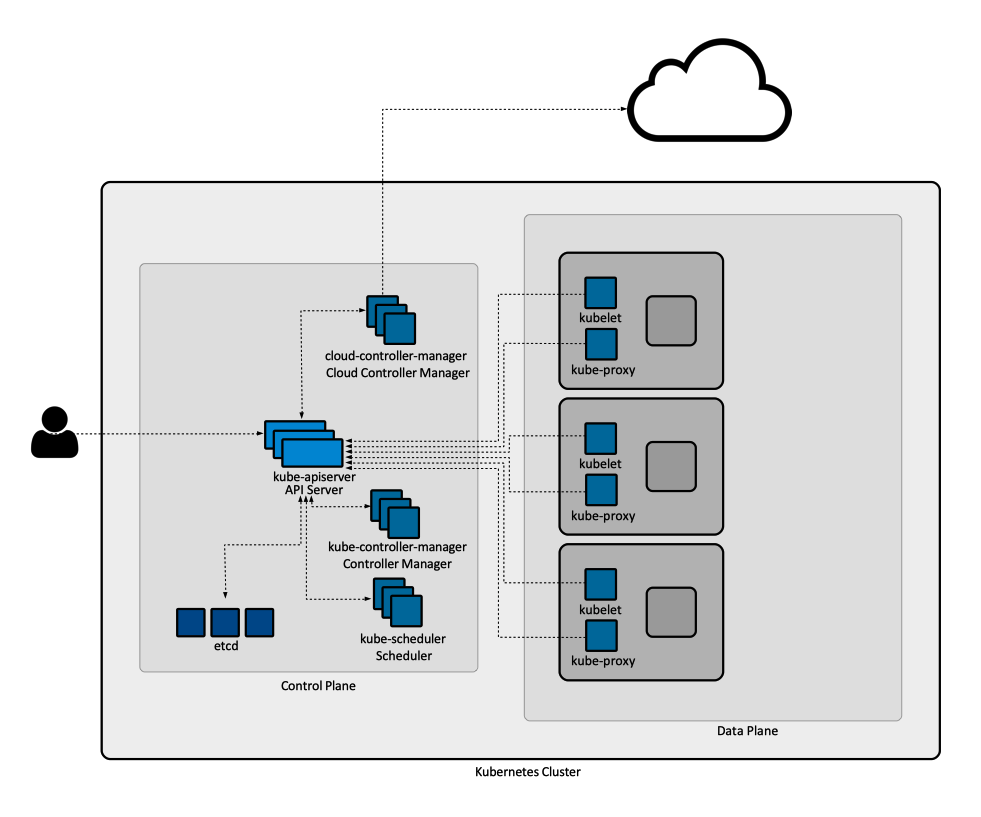Kubernetes Architecture
 Abhay Mahajan
Abhay Mahajan
Demystifying Kubernetes Clusters: Building Blocks and Real-World Comparisons
Imagine you're about to deploy Kubernetes, which is like orchestrating a symphony of containers. At the heart of this orchestration is the Kubernetes cluster, a core concept you need to grasp.
1. Kubernetes Cluster: The Ensemble
Think of a Kubernetes cluster as an organised group of worker machines called nodes. These nodes work together like a team of chefs in a busy kitchen. Their job is to prepare and serve dishes (your containerised applications) efficiently.
2. Worker Nodes: The Chefs in Action
Worker nodes are like the chefs in our kitchen. They are the ones who do the actual cooking and present the dishes. Each chef (node) can handle one or more plates (Pods) at a time. The plates hold all the ingredients and tools needed for a specific recipe (containerised app).
3. Control Plane: The Head Chef
In our culinary analogy, the control plane is the head chef. This experienced chef oversees the kitchen's operation, ensuring that each chef (worker node) is doing their job correctly. The head chef also manages the recipes (applications) and makes sure the right dishes (Pods) are prepared at the right time.
4. High Availability: Backup Chefs
Now, imagine a busy restaurant where customers expect their meals without interruptions. To ensure a seamless dining experience, we have backup chefs (additional nodes) in case a chef needs a break or encounters a problem. These backup chefs step in to maintain the restaurant's high standards, just like Kubernetes nodes ensure the availability and resilience of your applications.
In essence, a Kubernetes cluster is like a well-managed restaurant kitchen. The worker nodes are the chefs, the control plane is the head chef, and having multiple nodes provides redundancy and resilience, ensuring your "restaurant" (applications) runs smoothly, even when faced with unexpected challenges.
Understanding these components and their roles is your recipe for successful container orchestration with Kubernetes.

Exploring Kubernetes Control Plane Components
In the world of Kubernetes, the control plane is akin to the brains behind the operation. It makes critical decisions about your cluster and responds to various events. Let's explore the key control plane components:
1. kube-apiserver: The Front Desk
Think of kube-Apiserver as the welcoming front desk of a hotel. It's where guests (users and applications) check-in and request services. This component exposes the Kubernetes API, serving as the primary interface for interactions with the control plane. When you need to create, update, or manage resources in your cluster, you'll be interacting with the kube-apiserver.
2. etcd: The Secure Vault
Picture etcd as the ultra-secure vault where your cluster's valuable data is stored. It's similar to a bank's safe deposit box. All your cluster's configuration, state, and metadata find a safe home here. If your cluster relies on etcd, ensuring its reliability and maintaining backups is important. These backups serve as your insurance policy in case data recovery becomes necessary.
3. kube-scheduler: The Matchmaker
The kube-scheduler plays the role of a matchmaker for Pods and nodes. It's like a matchmaking service continuously on the lookout for Pods in need of a place to run (think of them as job applicants). The kube-scheduler excels at selecting the most suitable node (the best match) for each Pod. It considers factors such as resource requirements, constraints, and deadlines in its matchmaking process.
4. kube-controller-manager: The Task Organizer
Visualize kube-controller-manager as your trusted task organizer. It oversees various controllers, each tasked with specific responsibilities. These controllers closely monitor the cluster's state and take action to ensure the desired configuration is maintained. For example, the "Node controller" ensures the health of nodes, while the "Job controller" efficiently manages one-off tasks.
5. cloud-controller-manager: The Cloud Coordinator (Optional)
If your Kubernetes cluster operates in a cloud environment, the cloud controller manager steps in as the intermediary. It's like a translator bridging the communication between your cluster and the cloud provider's services. This component adeptly handles cloud-specific tasks, such as verifying node deletions in the cloud or managing cloud load balancers. If you're running Kubernetes on your local machine or on-premises, this component may not be needed.
In essence, the control plane components collaborate harmoniously to ensure the seamless operation of your Kubernetes cluster. Each component has a specific role, much like members of a well-organized team, working tirelessly to maintain the efficiency and security of your cluster.
Understanding Kubernetes Node Components
In the world of Kubernetes, each node in your cluster has its own set of roles and responsibilities. These node components work diligently to ensure your containers run smoothly and provide the runtime environment they need.
1. Kubelet: The Container Guardian
Think of Kubelet as the vigilant guardian of each node in your cluster. Its main job is to make sure containers are up and running inside Pods. Kubelet takes a list of instructions (PodSpecs) and ensures that the containers described in those instructions are not just running, but also in good health. It doesn't interfere with containers that weren't created by Kubernetes.
2. Kube-proxy: The Network Wizard
Kube-proxy is like a network wizard that resides on every node. It plays a crucial role in implementing the Kubernetes Service concept, which ensures network communication to your Pods. Kube-proxy maintains a set of rules for network traffic, allowing access to your Pods from both inside and outside the cluster. If there's an operating system packet filtering layer available, Kube-proxy uses it; otherwise, it takes charge of forwarding traffic itself.
3. Container Runtime: The Execution Maestro
Your Kubernetes cluster relies on a vital component known as the container runtime. Think of it as the conductor of a container orchestra. This component manages the execution and lifecycle of containers within the Kubernetes environment, ensuring they start, stop, and behave as expected.
Kubernetes supports various container runtimes like containerd, CRI-O, and more, which adhere to the Kubernetes Container Runtime Interface (CRI).
4. Addons: Enhancing Cluster Functionality
Add-ons are like the extra features that enhance your cluster's capabilities. They use Kubernetes resources, like DaemonSets and Deployments, to bring additional functionality to your cluster. These add-ons often reside within the kube-system namespace because they provide cluster-level features.
Here are a few essential add-ons:
DNS: Cluster DNS is a DNS server that serves DNS records for Kubernetes services. It's vital for smooth communication between Pods and services in your cluster.
Web UI (Dashboard): The Dashboard is a web-based interface that allows users to manage applications and troubleshoot cluster issues easily.
Container Resource Monitoring: This component records important metrics about containers and offers a user-friendly interface for exploring that data.
Cluster-level Logging: It saves container logs to a central log store and provides a search and browsing interface for effective log management.
Network Plugins: These software components follow the Container Network Interface (CNI) specification and handle IP allocation for Pods, enabling seamless communication within the cluster.
In essence, these node components, along with add-ons, form the backbone of your Kubernetes cluster. They work together harmoniously to ensure your containers are healthy, your network is efficient, and your cluster runs smoothly.
The Collaborative Symphony of Kubernetes Components
The efficacy of Kubernetes architecture hinges on the harmonious collaboration among its components. Here's a simplified breakdown of their collective endeavour:
Users and applications interact with the cluster through kube-apiserver, the gateway to the control plane, much like guests checking into a hotel through the front desk.
The control plane, fortified by etcd, makes informed decisions based on incoming requests and strives to maintain the cluster's desired state.
The kube-scheduler acts as the matchmaker, selecting the most suitable node for each Pod, akin to an algorithm matching online daters.
Kubelet, the tireless caretaker, implements instructions and monitors container health, much like a diligent gardener nurturing plants.
kube-proxy, the vigilant traffic officer, manages network traffic, ensuring seamless communication to and from Pods, similar to a police officer directing traffic flow at a busy intersection.
Add-ons elevate cluster functionality, providing essential features like DNS, monitoring, and logging, much like installing apps to enhance your smartphone's capabilities.
In essence, Kubernetes architecture resembles a symphony where each component plays its unique role, contributing to the efficient, secure, and scalable execution of your containerised applications.
Conclusion
Gaining a profound comprehension of Kubernetes architecture is pivotal for unleashing its full potential. It empowers you to deploy applications with confidence, scale resources seamlessly, and safeguard your cluster's resilience. As Kubernetes continually evolves, grasping its architecture serves as a foundational step in modernising your container orchestration infrastructure.
Kubernetes transcends being a mere technology; it emerges as a transformative framework, empowering your organisation to thrive in the realm of containerised applications. By mastering its architecture, you equip yourself to navigate the Kubernetes landscape and harness its boundless capabilities.
Subscribe to my newsletter
Read articles from Abhay Mahajan directly inside your inbox. Subscribe to the newsletter, and don't miss out.
Written by
